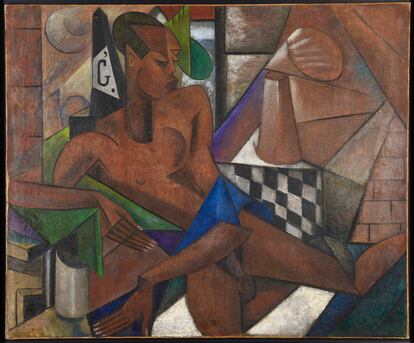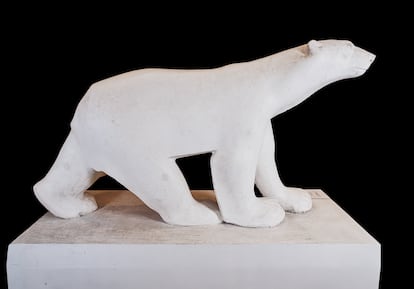The time the world changed: Paris at the beginning of the 20th century
The exhibition ‘Modern Paris’ at the Petit Palais reflects the profound transformations that culture, industry, and everyday life experienced at the turn of the century

Rarely in history can you identify a time and place where the world changed. One of them was Paris in the first two decades of the 20th century, when the city experienced a revolution not only in culture and artistic creativity, but also in industry and mobility.
The exhibition Modern Paris: 1905-1925, which can be seen at the Petit Palais museum until April 14, reflects that crucial period. “Culture, and all other aspects of life, underwent massive changes during those two decades, which occurred at breakneck speed and were particularly evident in Paris,” explains Juliette Singer, one of the museum’s curators, who has spent three years doing research to prepare the exhibition.
Although visual art carries a significant weight — there are paintings by Picasso, Chagall, Rousseau; photographs by Man Ray; drawings by Jean Cocteau; and a sculpture of a polar bear by François Pompon — it is by no means the only star.
The rooms of the Petit Palais feature dresses, airplanes, cars, watches, and jewelry. But the horror of the First World War is also represented, because the paradox is that this creative and technological explosion — which changed the way in which mankind thought, lived, and traveled — led to the first great catastrophe of the 20th century which, as the writer Geoff Dyer pointed out in his essay on the Battle of the Somme, anticipated all the other disasters of our time.

“Animal-powered vehicles gave way to automobiles, the urban landscape was transformed with the creation of the subway, airplanes crossed the English Channel, ocean liners linked continents, France’s first radio was installed on the Eiffel Tower in 1922,” Juliette Singer continues in an email interview. “The limits were continually being pushed, but this progress also had its negative side. During the First World War, airplanes became deadly weapons, launching bombs and shells. Photography and film were also developed, radically transforming our relationship with the world. This exhibition is a witness to all these changes, which not only nourished the artists, but also altered daily life: women became emancipated, people traveled more, and rigid social customs were relaxed.”
The exhibition does not make any reference to the present time, but it is difficult to see it without wondering where all the changes we are currently experiencing will take us, such as the rapid development of artificial intelligence, and if we will now be the unconscious protagonists in a similar revolution. In a beautiful book about his father, the filmmaker Jean Renoir explained that his father, the painter Pierre-Auguste Renoir, was born in 1841, when a large number of the inventions that were going to change the world had already been conceived. At the time, however, no one was able to predict how far-reaching they would be — the steam engine and the first hot air balloons were created at the end of the 18th century.
Jean Renoir writes in Renoir, my father: “The countryside had begun to empty towards the cities. The workers worked in the factories. The vegetables consumed in Paris came from the south, even from Algeria. We had a car. Renoir had a telephone. The roads were paved. Our house had heating, hot and cold water, gas, electricity, bathrooms.” That enormous transformation, in all aspects of life, is what the Petit Palais covers.

Golden age of creativity
The exhibition shows the incredible freedom of expression that was achieved in that golden age of creativity. But it is impossible not to think about the cataclysm that was going to be unleashed in the same time period, and in an atmosphere of total freedom, in which various artistic geniuses changed our way of thinking about the world. The 1920s was also the decade that saw the rise of fascism: Mussolini came to power in 1922 and Hitler, at the head of the Nazi Party, carried out a failed coup d’état in 1923.
“It was a time marked by enormous freedom,” says Juliette Singer. “It coincided with the proclamation of the 1905 law that separated Church and State in France. This secularism was a source of freedom for artists like Soutine, a Jew from Belarus, where all representation was prohibited. On the other side of the Atlantic, the United States was governed by segregation laws and, in 1917 Joséphine Baker — still a teenager at the time — escaped racial attacks in Saint Louis, where a real bloodbath occurred.
In stark contrast, Paris seemed like a city of ‘light and freedom’, to borrow a phrase from Marc Chagall. André Warnod, in Berceaux de la jeune peinture, described Paris as a haven of freedom, where everyone, including women, could live as they wanted. Beginning in 1920, many Americans fled to Paris to escape Prohibition. As Ernest Hemingway said at the time, ‘Paris is a party’... Everything was allowed.”

In 2022, Joséphine Baker became the sixth woman to be buried in the Pantheon — the highest posthumous honor granted by the French Republic. She occupies a very significant place in the exhibition. She can be seen dancing in some tremendously fun and evocative images of a time in which many barriers were broken. It also calls at the Ballets Suédois which, between 1920 and 1925, “was always pushing the limits of creation a little further by blending different disciplines, like painting, music, and dance,” according to a text by the essayist Berenice Geoffroy Schneiter that is reproduced in the exhibition catalogue. For five seasons, these ballets caused a real sensation in the theater of the Champs-Elysées in Paris and in other European capitals.
The American artist, who adopted French nationality in 1937 and who participated in the Resistance against the Nazi occupation, symbolizes the best of a progressive era. She was able to fight against racism — a message that, once again, extends to the present in which far-right parties occupy a growing space in many countries.
“Baker was dazzled by the freedom she discovered in Paris, where there were no segregationist laws and she could have a coffee in any establishment and be treated like anyone else,” explains Juliette Singer. “At night she changed her theater costumes for haute couture dresses and made a name for herself in Paris with her humor and wit. This society welcomed her with open arms and she became the highest-paid artist of her time, leaving her mark as a music hall performer, singer, and film actress. Her love for Paris and the freedom she found seemed to me emblematic of the spirit of modern Paris, where a 17-year-old multiracial girl who was born in a shanty town was able to chart an extraordinary career in a context in which everything seemed possible... until the crisis of 1929 and then the Second World War.”

Sign up for our weekly newsletter to get more English-language news coverage from EL PAÍS USA Edition
Tu suscripción se está usando en otro dispositivo
¿Quieres añadir otro usuario a tu suscripción?
Si continúas leyendo en este dispositivo, no se podrá leer en el otro.
FlechaTu suscripción se está usando en otro dispositivo y solo puedes acceder a EL PAÍS desde un dispositivo a la vez.
Si quieres compartir tu cuenta, cambia tu suscripción a la modalidad Premium, así podrás añadir otro usuario. Cada uno accederá con su propia cuenta de email, lo que os permitirá personalizar vuestra experiencia en EL PAÍS.
¿Tienes una suscripción de empresa? Accede aquí para contratar más cuentas.
En el caso de no saber quién está usando tu cuenta, te recomendamos cambiar tu contraseña aquí.
Si decides continuar compartiendo tu cuenta, este mensaje se mostrará en tu dispositivo y en el de la otra persona que está usando tu cuenta de forma indefinida, afectando a tu experiencia de lectura. Puedes consultar aquí los términos y condiciones de la suscripción digital.
More information
Archived In
Últimas noticias
Welcome to the post-religion era: The idea of Christianity as the absolute truth has become obsolete
‘I thought you would like it’: The risky sexual practice popularized by TV shows and TikTok
The digitalization of tourism: ‘They promise experiences and gave us the worst possible one’
Mexican peso defies uncertainty with forecasts of a new period of stability in 2026
Most viewed
- Sinaloa Cartel war is taking its toll on Los Chapitos
- Oona Chaplin: ‘I told James Cameron that I was living in a treehouse and starting a permaculture project with a friend’
- Reinhard Genzel, Nobel laureate in physics: ‘One-minute videos will never give you the truth’
- Why the price of coffee has skyrocketed: from Brazilian plantations to specialty coffee houses
- Silver prices are going crazy: This is what’s fueling the rally










































